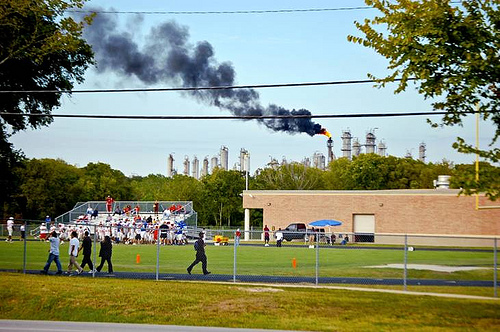Disasters and Environmental Vulnerability Research Begins in Manchester, Houston
Date: 12/15/2016
Author: Jennifer Horney
Nearing the end of the Fall Semester a group of 13 graduate students from the School of Public Health travelled with faculty and research staff to the marginalized neighborhood of Manchester as part of the Disasters and Environmental Vulnerability project. This community rests along the banks of the Houston Ship Channel. These student researchers are members of EpiAssist, a program led by Dr. Jennifer Horney at Texas A&M University, that provides student volunteers with the opportunity to gain applied public health experience by assisting in Texas with outbreak investigations, disasters and emergencies, community health assessments, and other projects. The researchers were accompanied by the Texas Environmental Advocacy Services (t.e.j.a.s), a local advocacy organization dedicated to the betterment of local community members and the environment.
The neighborhoods located along the Houston Ship Channel, including the Manchester neighborhood, have been documented as having excess risk of exposure to acute pollution, emergency chemical spills and incidents, and high-impact natural and manmade disaster events. These exposures have been linked to poor health outcomes including cancer clusters in both children and adults and more than twice the rate of respiratory disease when compared to other Texans. In response to these and other documented excess exposures and health risks, neighborhood residents and affiliated organizations have long been involved in community engagement activities around environmental justice.
In order to better understand the impact on human wellbeing these exposures have, health information and environmental samples were taken from homes within the neighborhood. The teams conducted in-person health surveys and collected samples of tap water and dust from the homes.

The results of this study will provide a better understand of the potential hazards to which the residents living in the Manchester area are routinely exposed. Exposures The water and dust samples that were collected from the neighborhood are being analyzed to evaluate the presence of contaminants such as benzene, volatile organic compounds, and polycyclic aromatic hydrocarbons, all of which could be detrimental to resident’s health.
The primary objective of this investigation is to assess the presence of environmental contaminants in households that may contribute to adverse health outcomes. The findings of this research will provide an indication as to whether potential hazards are present in the drinking water and residences located in the Manchester neighborhood of Houston, Texas. The results of this assessment will provide a baseline of scientifically-derived data that may be leveraged to determine whether subsequent studies are warranted and, if deemed necessary, to procure additional research funding. This knowledge could be applied by community members, environmental advocacy organizations, and other local stakeholders to inform future policy directives and guide risk reduction measures that could mitigate health disparities that may be linked to inequitable exposure to environmental contaminants.
The results of this study could provide evidence of household environmental contaminants that could lead to unhealthy exposures. These findings will inform policy makers and the public of the present dangers that the Manchester community members experience.